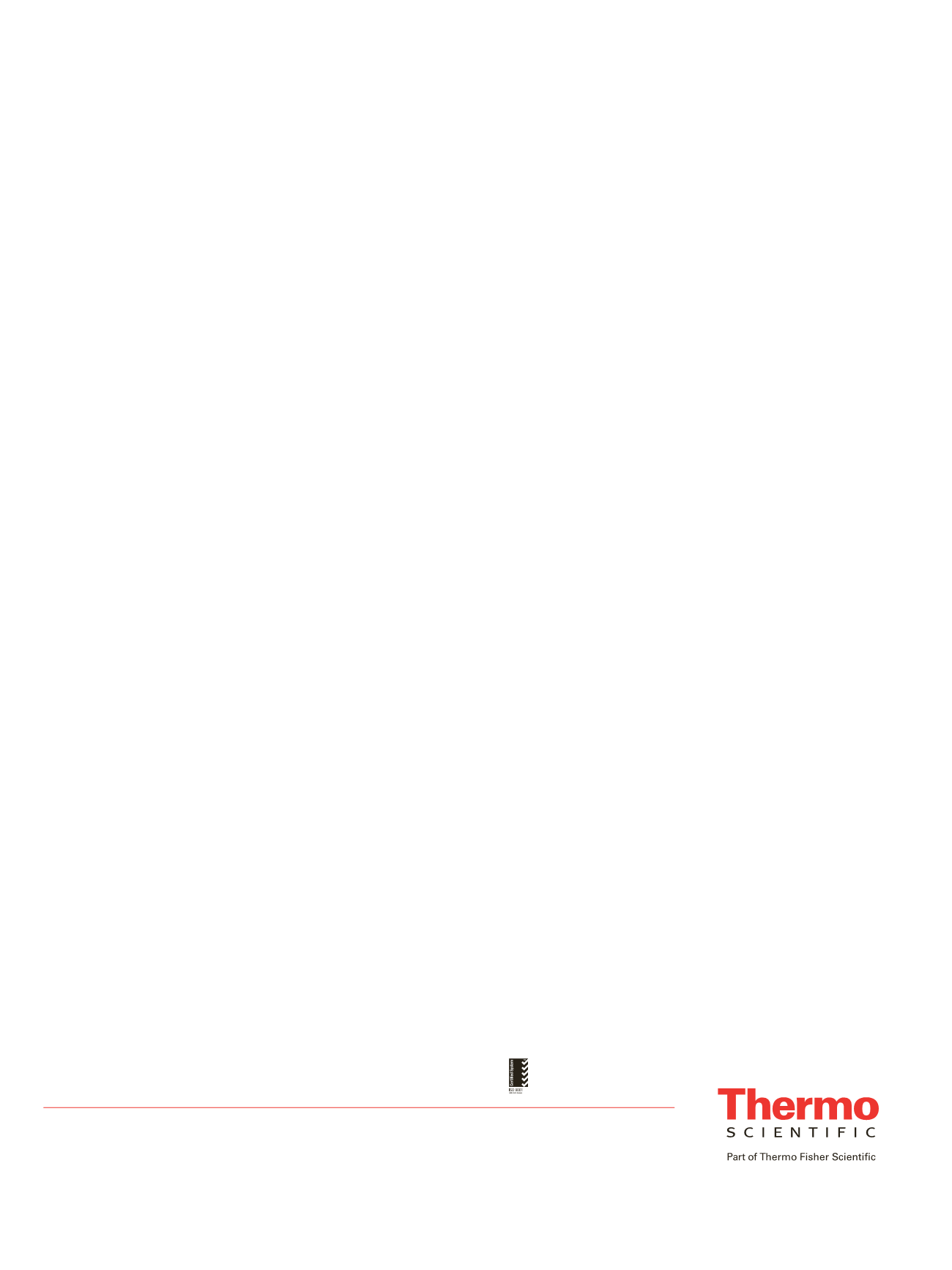

The GC injection method and column separation has
been optimized for the injection of 4 uL of extract, using
GC columns of standard film and dimensions, typically
used for other types of residue analysis as well, so that a
column change to a specific column for CS
2
determination
only is not required.
The mass spectrometer ion source conditions had been
optimized for best sensitivity and S/N ratio. The analysis
in SIM mode is preferred providing a high selectivity with
easy to integrate chromatograms.
This method has been developed initially for the ITQ ion
trap mass spectrometer, but the same parameter setup is
suitable for the Thermo Scientific™ ISQ™ series single
quadrupole or Thermo Scientific™ TSQ™ Quantum
XLS Ultra or Thermo Scientific™ TSQ 8000™ triple
quadrupole mass spectrometers, as well.
References
[1] Crnogorac, G., Schwack, W., Residue analysis of
dithiocarbamatefungicides, Trends in Analytical
Chemistry, Vol. 28, No. 1, 2009.
[2] Reynolds, S., Analysis of Dithiocarbamates, presented
at the SELAMAT Workshop, Bangkok 2006.
[3] Analysis of Dithiocarbamate Residues in
Foods of Plant Origin involving Cleavage into
Carbon Disulfide, Partitioning into Isooctane
and Determinative Analysis by GC-ECD. http://
www.crl-pesticides.eu/library/docs/srm/meth_DithiocarbamatesCS
2
_EurlSrm.PDF
[4] Amvrazi, Elpiniki G., Fate of Pesticide Residues on
Raw Agricultural Crops after Postharvest Storage
and Food Processing to Edible Portions, Pesticides
- Formulations, Effects, Fate, Prof. Margarita
Stoytcheva(Ed.), ISBN: 978-953-307-532-7.
Precision
The precision of repeatability was determined by three
analysts preparing six samples each on a single day.
The intermediate precision was determined by the same
analysts with six samples each on six different days. The
method precision was determined with 0.04 mg/kg.
General Guidelines for DTC Analysis
The analysis of cruciferous crops, including brassica
samples, may not be unequivocal, because they contain
naturally occurring compounds that may generate carbon
disulfide.
It is necessary to avoid the use of rubber material
(natural/synthetic) e.g. gloves, when performing DTC
analyses as they contain dithiocarbamates, and this could
lead to contamination problems. Silicone rubber and
polyethylene do not contain dithiocarbamate.
Samples, other than fresh foodstuffs, will be comminuted
by cryogenic milling. Fresh samples should be sub-
sampled prior to extraction by removing segments from
fresh samples following current Codex Alimentarius
guidelines.
The samples should be analyzed within 4 weeks of
cryogenic milling. If the storage of fresh produce is
necessary it should be in a cool place (<-10°C) keeping
condensation at minimum
[4]
.
Conclusions
A reliable routine method for the analysis of
dithiocarbamates with high precision in different
vegetable and fruits has been developed. The method
allows a wide calibration range of 0.04 – 1.300 µg/mL
Thiram. The LOQ has been determined as 0.04 µg/mL.
The extraction uses a SnCl
2
/HCl acid-hydrolysis with iso-
octane as solvent to form CS
2
which finally gets quantified
by GC-MS. The recovery from different food commodities
has been shown to be very high with 79 to 104%.
AN10333_E 07/13S
Africa-Other
+27 11 570 1840
Australia
+61 3 9757 4300
Austria
+43 1 333 50 34 0
Belgium
+32 53 73 42 41
Canada
+1 800 530 8447
China
+86 10 8419 3588
Denmark
+45 70 23 62 60
Europe-Other
+43 1 333 50 34 0
Finland/Norway/Sweden
+46 8 556 468 00
France
+33 1 60 92 48 00
Germany
+49 6103 408 1014
India
+91 22 6742 9434
Italy
+39 02 950 591
Japan
+81 45 453 9100
Latin America
+1 561 688 8700
Middle East
+43 1 333 50 34 0
Netherlands
+31 76 579 55 55
New Zealand
+64 9 980 6700
Russia/CIS
+43 1 333 50 34 0
South Africa
+27 11 570 1840
Spain
+34 914 845 965
Switzerland
+41 61 716 77 00
UK
+44 1442 233555
USA
+1 800 532 4752
www.thermoscientific.com©2012 Thermo Fisher Scientific Inc. All rights reserved. ISO is a trademark of the International Standards Organization.
All other trademarks are the property of Thermo Fisher Scientific Inc. and its subsidiaries. This information is presented as an
example of the capabilities of Thermo Fisher Scientific Inc. products. It is not intended to encourage use of these products in any
manners that might infringe the intellectual property rights of others. Specifications, terms and pricing are subject to change.
Not all products are available in all countries. Please consult your local sales representative for details.
Thermo Fisher Scientific,
Austin, TX USA is ISO 9001:2008 Certified.



















